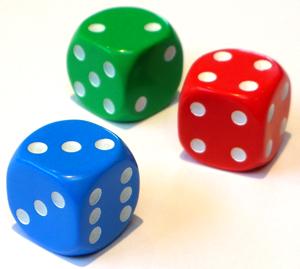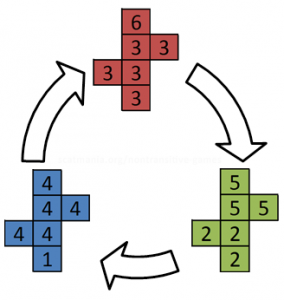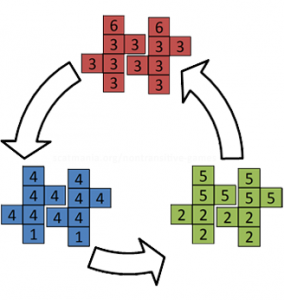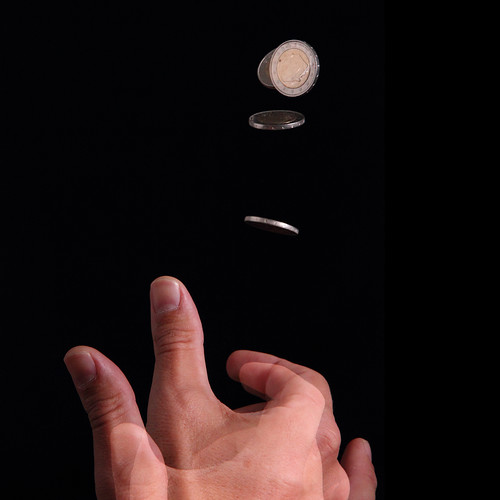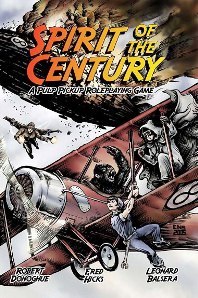Dungeons & Dragons players spend a lot of time rolling 20-sided polyhedral dice, known as D20s.
In general, they’re looking to roll as high as possible to successfully stab a wyvern, jump a chasm, pick a lock, charm a Duke1, or whatever.
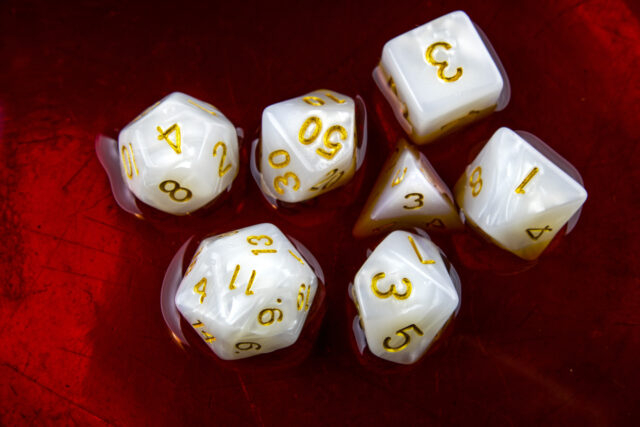
Roll with advantage
Sometimes, a player gets to roll with advantage. In this case, the player rolls two dice, and takes the higher roll. This really boosts their chances of not-getting a low roll. Do you know by how much?
I dreamed about this very question last night. And then, still in my dream, I came up with the answer2. I woke up thinking about it3 and checked my working.
| 1 | 2 | 3 | 4 | 5 | 6 | 7 | 8 | 9 | 10 | 11 | 12 | 13 | 14 | 15 | 16 | 17 | 18 | 19 | 20 | |
|---|---|---|---|---|---|---|---|---|---|---|---|---|---|---|---|---|---|---|---|---|
| 1 | 1 | 2 | 3 | 4 | 5 | 6 | 7 | 8 | 9 | 10 | 11 | 12 | 13 | 14 | 15 | 16 | 17 | 18 | 19 | 20 |
| 2 | 2 | 2 | 3 | 4 | 5 | 6 | 7 | 8 | 9 | 10 | 11 | 12 | 13 | 14 | 15 | 16 | 17 | 18 | 19 | 20 |
| 3 | 3 | 3 | 3 | 4 | 5 | 6 | 7 | 8 | 9 | 10 | 11 | 12 | 13 | 14 | 15 | 16 | 17 | 18 | 19 | 20 |
| 4 | 4 | 4 | 4 | 4 | 5 | 6 | 7 | 8 | 9 | 10 | 11 | 12 | 13 | 14 | 15 | 16 | 17 | 18 | 19 | 20 |
| 5 | 5 | 5 | 5 | 5 | 5 | 6 | 7 | 8 | 9 | 10 | 11 | 12 | 13 | 14 | 15 | 16 | 17 | 18 | 19 | 20 |
| 6 | 6 | 6 | 6 | 6 | 6 | 6 | 7 | 8 | 9 | 10 | 11 | 12 | 13 | 14 | 15 | 16 | 17 | 18 | 19 | 20 |
| 7 | 7 | 7 | 7 | 7 | 7 | 7 | 7 | 8 | 9 | 10 | 11 | 12 | 13 | 14 | 15 | 16 | 17 | 18 | 19 | 20 |
| 8 | 8 | 8 | 8 | 8 | 8 | 8 | 8 | 8 | 9 | 10 | 11 | 12 | 13 | 14 | 15 | 16 | 17 | 18 | 19 | 20 |
| 9 | 9 | 9 | 9 | 9 | 9 | 9 | 9 | 9 | 9 | 10 | 11 | 12 | 13 | 14 | 15 | 16 | 17 | 18 | 19 | 20 |
| 10 | 10 | 10 | 10 | 10 | 10 | 10 | 10 | 10 | 10 | 10 | 11 | 12 | 13 | 14 | 15 | 16 | 17 | 18 | 19 | 20 |
| 11 | 11 | 11 | 11 | 11 | 11 | 11 | 11 | 11 | 11 | 11 | 11 | 12 | 13 | 14 | 15 | 16 | 17 | 18 | 19 | 20 |
| 12 | 12 | 12 | 12 | 12 | 12 | 12 | 12 | 12 | 12 | 12 | 12 | 12 | 13 | 14 | 15 | 16 | 17 | 18 | 19 | 20 |
| 13 | 13 | 13 | 13 | 13 | 13 | 13 | 13 | 13 | 13 | 13 | 13 | 13 | 13 | 14 | 15 | 16 | 17 | 18 | 19 | 20 |
| 14 | 14 | 14 | 14 | 14 | 14 | 14 | 14 | 14 | 14 | 14 | 14 | 14 | 14 | 14 | 15 | 16 | 17 | 18 | 19 | 20 |
| 15 | 15 | 15 | 15 | 15 | 15 | 15 | 15 | 15 | 15 | 15 | 15 | 15 | 15 | 15 | 15 | 16 | 17 | 18 | 19 | 20 |
| 16 | 16 | 16 | 16 | 16 | 16 | 16 | 16 | 16 | 16 | 16 | 16 | 16 | 16 | 16 | 16 | 16 | 17 | 18 | 19 | 20 |
| 17 | 17 | 17 | 17 | 17 | 17 | 17 | 17 | 17 | 17 | 17 | 17 | 17 | 17 | 17 | 17 | 17 | 17 | 18 | 19 | 20 |
| 18 | 18 | 18 | 18 | 18 | 18 | 18 | 18 | 18 | 18 | 18 | 18 | 18 | 18 | 18 | 18 | 18 | 18 | 18 | 19 | 20 |
| 19 | 19 | 19 | 19 | 19 | 19 | 19 | 19 | 19 | 19 | 19 | 19 | 19 | 19 | 19 | 19 | 19 | 19 | 19 | 19 | 20 |
| 20 | 20 | 20 | 20 | 20 | 20 | 20 | 20 | 20 | 20 | 20 | 20 | 20 | 20 | 20 | 20 | 20 | 20 | 20 | 20 | 20 |
The chance of getting a “natural 1” result on a D20 is 1 in 20… but when you roll with advantage, that goes down to 1 in 400: a huge improvement! The chance of rolling a 10 or 11 (2 in 20 chance of one or the other) remains the same. And the chance of a “crit” – 20 – goes up from 1 in 20 when rolling a single D20 to 39 in 400 – almost 10% – when rolling with advantage.
You can see that in the table above: the headers along the top and left are the natural rolls, the intersections are the resulting values – the higher of the two.
The nice thing about the table above (which again: was how I visualised the question in my dream!) is it really helps to visualise why these numbers are what they are. The general formula for calculating the chance of a given number when rolling D20 with advantage is ( n2 – (n-1)2 ) / 400. That is, the square of the number you’re looking for, minus the square of the number one less than that, over 400 (the total number of permutations)4.
Why roll two dice when one massive one will do?
Knowing the probability matrix, it’s theoretically possible to construct a “D20 with Advantage” die5. Such a tool would have 400 sides (one 1, three 2s, five 3s… and thirty-nine 20s). Rolling-with-advantage would be a single roll.
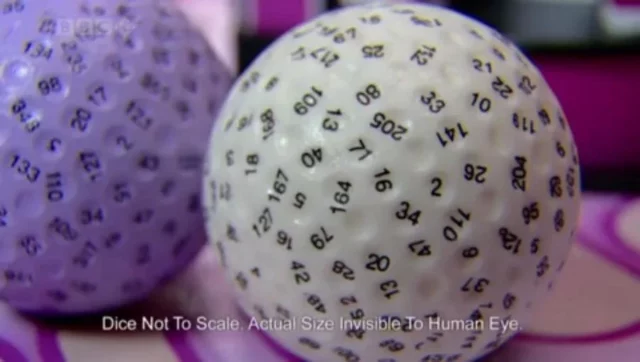
This is probably a totally academic exercise. The only conceivable reason I can think of would be if you were implementing a computer system on which generating random numbers was computationally-expensive, but memory was cheap: under this circumstance, you could pre-generate a 400-item array of possible results and randomly select from it.
But if anybody’s got a 3D printer capable of making a large tetrahectogon (yes, that’s what you call a 400-sided polygon – you learned something today!), I’d love to see an “Advantage D20” in the flesh. Or if you’d just like to implement a 3D model for Dice Box that’d be fine too!
Footnotes
1 Or throw a fireball, recall an anecdote, navigate a rainforest, survive a poisoning, sneak past a troll, swim through a magical swamp, hold on to a speeding aurochs, disarm a tripwire, fire a crossbow, mix a potion, appeal to one among a pantheon of gods, beat the inn’s landlord at an arm-wrestling match, seduce a duergar guard, persuade a talking squirrel to spy on some bandits, hold open a heavy door, determine the nature of a curse, follow a trail of blood, find a long-lost tome, win a drinking competition, pickpocket a sleeping ogre, bury a magic sword so deep that nobody will ever find it, pilot a spacefaring rowboat, interpret a forgotten language, notice an imminent ambush, telepathically commune with a distant friend, accurately copy-out an ancient manuscript, perform a religious ritual, find the secret button under the wizard’s desk, survive the blistering cold, entertain a gang of street urchins, push through a force field, resist mind control, and then compose a ballad celebrating your adventure.
2 I don’t know what it says about me as a human being that sometimes I dream in mathematics, but it perhaps shouldn’t be surprising given I’m nerdy enough to have previously recorded instances of dreaming in (a) Perl, and (b) Nethack (terminal mode).
3 When I woke up I also found that I had One Jump from Disney’s Aladdin stuck in my head, but I’m not sure that’s relevant to the discussion of probability; however, it might still be a reasonable indicator of my mental state in general.
4 An alternative formula which is easier to read but harder to explain would be ( 2(n – 1) + 1 ) / 400.
5 Or a “D20 with Disadvantage”: the table’s basically the inverse of the advantage one – i.e. 1 in 400 chance of a 20 through to 39 in 400 chance of a 1.
